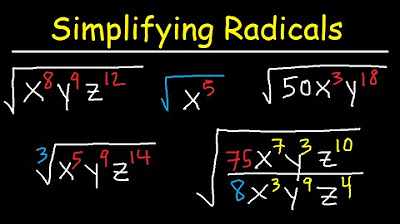SIMPLIFICACIÓN DE EXPRESIONES CON RADICALES - Ejercicio 1
Summary
TLDRThe script is a detailed tutorial on simplifying expressions involving square roots. It explains how to factorize numbers like 27, 75, and 48 into prime factors and simplify square roots accordingly. The process involves ensuring exponents are divisible by 2 for easy extraction from the square root. It also discusses how to handle terms inside the square root, emphasizing multiplication over addition or subtraction for successful simplification. The tutorial concludes with combining like radicals and canceling out common factors to obtain a simplified result.
Takeaways
- 🔢 The process starts by factoring the radicands (27, 75, and 48) into their prime factors.
- 📏 The goal is to rewrite the exponents in a way that makes them divisible by the root's index (in this case, 2).
- 🧮 The number 27 is factored into 3^3, and rewritten as 3^2 * 3 to ensure divisibility by 2.
- ✅ For 75, the prime factorization is 3 * 5^2. The 5^2 term is divisible by 2, making it easy to handle in the square root.
- ⚖️ For 48, the prime factorization is 2^4 * 3. The 2^4 term can be extracted from the square root since 4 is divisible by 2.
- ↔️ The terms that are divisible by 2 (such as 3^2, 5^2, and 2^4) can be simplified outside the square roots.
- 🧩 Similar to combining like terms in algebra, 'radicales semejantes' (like radicals) can be added together.
- 🧮 After combining, the numerator becomes 8√3, and the denominator simplifies to 4√3.
- ✂️ Since √3 is present in both the numerator and denominator, it can be canceled out, leaving 8/4.
- 🏁 The final simplified result of the entire expression is 2.
Q & A
What is the first step in simplifying the given expression?
-The first step is to decompose each radicand into prime factors.
How is the number 27 decomposed in terms of prime factors?
-27 is decomposed as 3^3 since 3^3 = 27.
Why is it important to have exponents divisible by 2 when dealing with square roots?
-Exponents divisible by 2 allow the expression inside the square root to be simplified, as they can be taken out of the root.
What is done to the exponent of 3 in the number 27 to make it divisible by 2?
-The exponent of 3 is decomposed into 3^2 * 3^1 to ensure that the exponent is divisible by 2.
How is the expression for 75 simplified in terms of prime factors?
-75 is decomposed into 3 * 5^2 after recognizing that 75 = 3 * 5^2.
What is the significance of the exponent being 2 in the term 5^2?
-The exponent 2 is significant because it is divisible by 2, allowing the term to be simplified when taking the square root.
How is the number 48 decomposed into prime factors?
-48 is decomposed into 2^4 * 3 because 48 = 2^4 * 3.
Why can't the term with an exponent of 1 (like 3^1) be taken out of the square root?
-A term with an exponent of 1 cannot be taken out of the square root because 1 is not divisible by 2.
What is the concept of 'like radicals' or 'radicand semejantes' mentioned in the script?
-Like radicals or 'radicand semejantes' refer to terms under the same radical that can be combined, similar to like terms in algebra.
How are the terms under the square root combined in the simplified expression?
-The terms under the square root are combined by adding the coefficients, similar to combining like terms in algebra.
What is the final result of the simplified expression according to the script?
-The final result of the simplified expression is 2.
Outlines

Cette section est réservée aux utilisateurs payants. Améliorez votre compte pour accéder à cette section.
Améliorer maintenantMindmap

Cette section est réservée aux utilisateurs payants. Améliorez votre compte pour accéder à cette section.
Améliorer maintenantKeywords

Cette section est réservée aux utilisateurs payants. Améliorez votre compte pour accéder à cette section.
Améliorer maintenantHighlights

Cette section est réservée aux utilisateurs payants. Améliorez votre compte pour accéder à cette section.
Améliorer maintenantTranscripts

Cette section est réservée aux utilisateurs payants. Améliorez votre compte pour accéder à cette section.
Améliorer maintenantVoir Plus de Vidéos Connexes

Simplifying Radicals With Variables, Exponents, Fractions, Cube Roots - Algebra

Simplifying Expressions Involving Indices | O Level Additional Mathematics

Simplest Radical Form

Tips Mudah Menyederhanakan Bentuk Akar || Bab Bilangan Berpangkat (Part 2)

4 Laws of Radicals: Grade 9 Quarter 2

RACIONALIZAÇÃO DE DENOMINADORES RESUMÃO
5.0 / 5 (0 votes)
